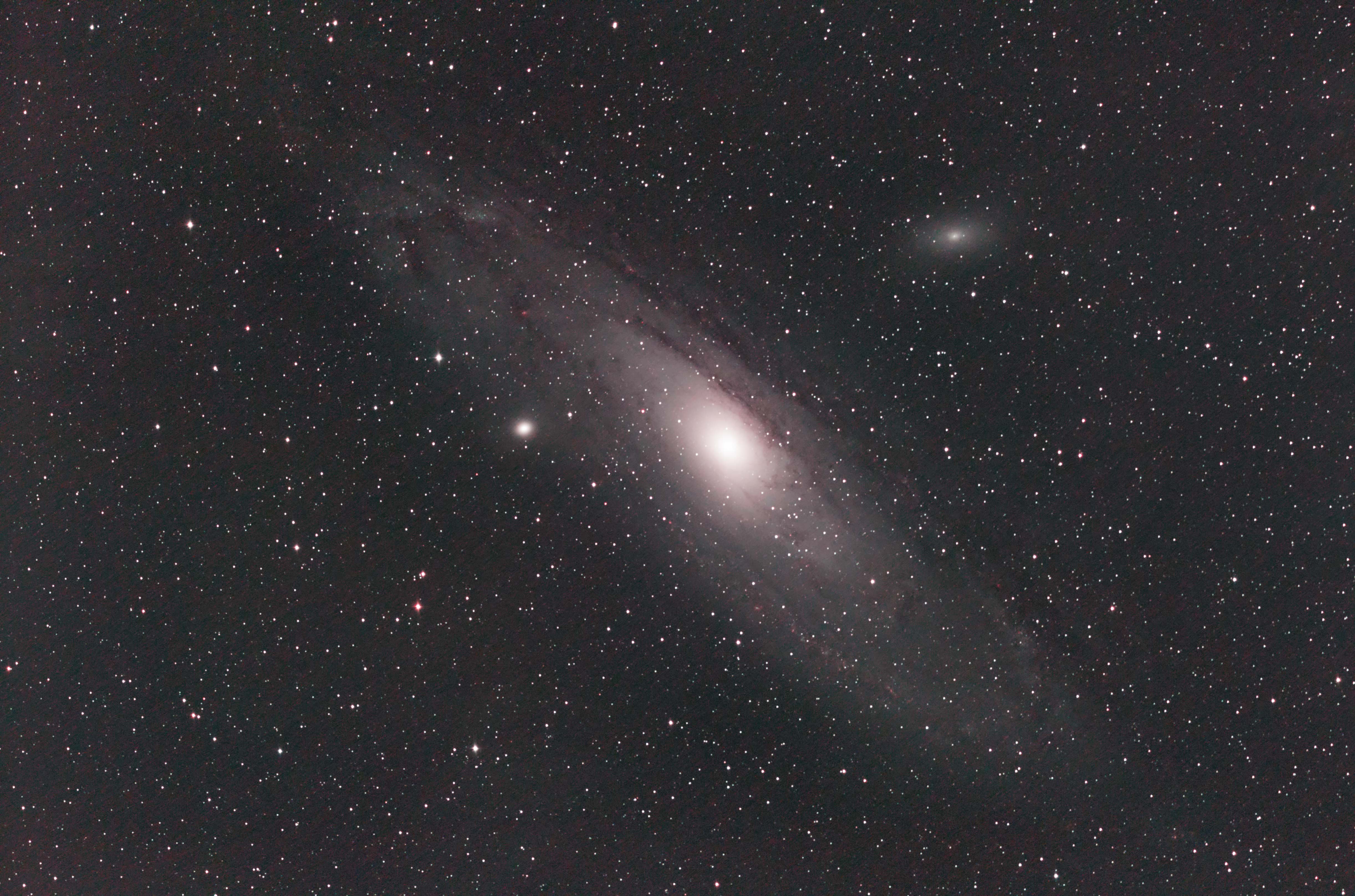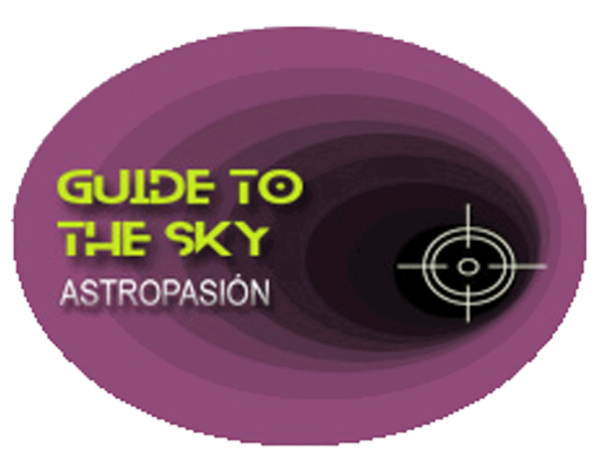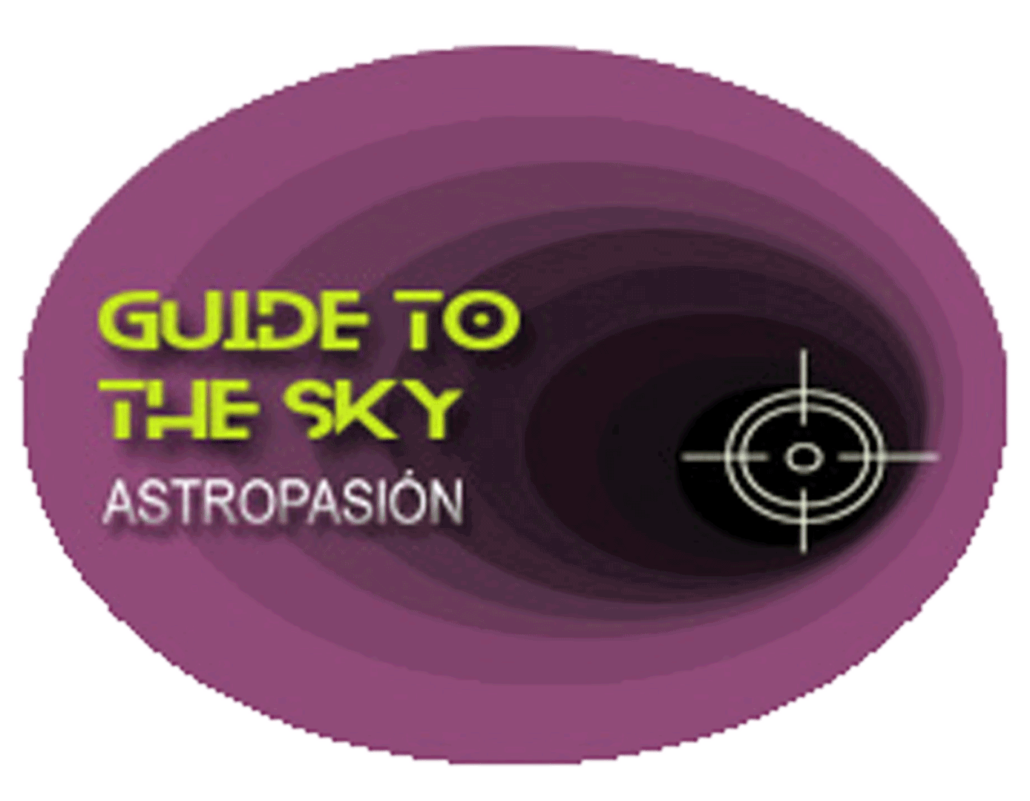Messier 31 - Andromeda

M 31 es una espiral gemela de La Vía Láctea, aunque de tipo Sab - nuestra Vía Láctea es una espiral barrada - y algo mayor en tamaño y masa, está situada a {{ object[0].M31.mesDistances[0].dist }} {{ object[0].M31.mesDistances[0].unit }} de nosotros.
Visualmente es un objeto realmente espectacular, con un tamaño aproximado de más de 3º en su eje mayor, es decir, unas 6 lunas llenas puestas en fila. Brilla con una magnitud visual de {{ object[0].M31.visualMagnitude }}. M31 constituye un buen test para evaluar la calidad del cielo o la escala Bortle, en teoría si estamos en una calidad Bortle 8 - esto es, en cielos urbanos no demasiado iluminados - deberíamos poder barruntarla a ojo desnudo si sabemos donde está.
En los brazos espirales de esta gran galaxia, es posible obtener en fotografías de gran exposición regiones HII, nebulosas y agrupaciones estelares, una de ellas, es la NGC 206, se cree que es uno de los mayores cúmulos abiertos de todo el Grupo Local. M 31 está también plagada de nebulosas oscuras a lo largo su plano galáctico, que diseñan su estructura en espiral, alguna de las cuales muy próximas de su núcleo.
Un dato interesante es que M 31 se acerca a la Vía Láctea a unos 300km/s, de tal suerte que colisionará con nosotros, aunque no debemos preocuparnos por ahora, pues se estima que la colisión no será antes de unos 5000 años.
Son espectaculares también sus satélites M32 y NGC 205 (M110) las cuales tienen suficiente entidad para que las tratemos en capítulos aparte.
M31 - Gran Galaxia de Andrómeda - en la IA
Messier 31, also known as the Andromeda Galaxy, is a truly remarkable object. Here's a breakdown of key facts and information:
What it is:
- A Spiral Galaxy: Andromeda is a massive spiral galaxy, similar to our own Milky Way, but perhaps even larger.
- Our Galactic Neighbor: It's the closest major galaxy to the Milky Way.
- Part of the Local Group: Both the Milky Way and Andromeda belong to the Local Group, a collection of galaxies bound together by gravity.
Key Characteristics:
- Distance: Approximately 2.537 million light-years from Earth.
- Size: Estimated to be about 220,000 light-years in diameter, potentially larger than the Milky Way.
- Mass: Estimated to be comparable to or slightly greater than the Milky Way's mass, perhaps 1.5 trillion solar masses.
- Stars: Contains an estimated 1 trillion stars.
- Central Supermassive Black Hole: Like most large galaxies, Andromeda harbors a supermassive black hole at its center, estimated to be around 100 million times the mass of the Sun.
How to Observe It:
- Visibility: Under dark skies, away from light pollution, Andromeda can be seen with the naked eye as a faint, fuzzy patch of light.
- Best Time to View: Best observed in the autumn and winter months in the Northern Hemisphere.
- Location: Located in the constellation Andromeda. To find it, locate the Great Square of Pegasus. Follow the two stars on the left of the square "up" and "left," and you'll find Andromeda. Look for a faint, elongated glow.
- Telescopes & Binoculars: Binoculars or a small telescope will reveal more detail, showing a larger, brighter core and a hint of its spiral arms. Larger telescopes reveal even more structure and detail.
Significance:
- Future Collision: Andromeda is on a collision course with the Milky Way. In about 4.5 billion years, the two galaxies are predicted to merge, forming a giant elliptical galaxy, sometimes nicknamed "Milkomeda" or "Milkdromeda." This is a long way off, and it's more of a cosmic dance than a violent crash, as the vast spaces between stars mean direct collisions between individual stars are unlikely.
- Understanding Galaxy Formation: Studying Andromeda helps astronomers understand the formation, evolution, and structure of spiral galaxies.
- Extragalactic Studies: As our closest major galactic neighbor, Andromeda is an important "stepping stone" for studying galaxies further away in the universe.
History:
- First Mentioned: First mentioned in the 964 AD by the Persian astronomer Al-Sufi, who described it as a "nebulous smear."
- Messier Catalog: Included as object number 31 in Charles Messier's catalog of nebulous objects in 1764.
- Island Universe: In the 1920s, Edwin Hubble's observations of Cepheid variable stars in Andromeda demonstrated that it was a galaxy far beyond the Milky Way, settling the debate about the nature of "spiral nebulae" and confirming the existence of galaxies beyond our own.
In Summary:
Messier 31 (the Andromeda Galaxy) is a beautiful, immense, and scientifically important galaxy. Its visibility to the naked eye is a testament to its size and proximity, and its impending collision with the Milky Way offers a glimpse into the distant future of our own galaxy. It's a fascinating object to observe and contemplate.
Más información sobre Messier 31 en NASA/IPAC.
Mapa alrededor de Messier 31
Otros identificadores de M31:
"4FGL J0043.2+4114" ,"PLX 124" ,"AG+40 60" ,"BD+40 148" ,"HD 3969" ,"PPM 43228" ,"PLX 124.00" ,"SRGA J004241.1+411603" ,"2C 56" ,"DA 21" ,"GIN 801" ,"IRAS F00400+4059" ,"IRAS 00400+4059" ,"IRC +40013" ,"K79 1C" ,"LEDA 2557" ,"M 31" ,"MCG+07-02-016" ,"NAME Andromeda" ,"NAME Andromeda Galaxy" ,"NGC 224" ,"RAFGL 104" ,"UGC 454" ,"XSS J00425+4102" ,"Z 535-17" ,"Z 0040.0+4100" ,"[DGW65] 4" ,"2MASX J00424433+4116074" ,"[M98c] 004000.1+405943" ,"[VV2000c] J004244.3+411610","[VV2003c] J004244.3+411610","[VV2006] J004244.3+411610" ,"[VV98c] J004245.1+411622" ,"UZC J004244.3+411608" ,"[VV2010] J004244.3+411610" ,"NAME And Nebula" ,"NAME Andromeda Nebula" ,"2MAXI J0043+412" ,"3FGL J0042.5+4117" ,"2FGL J0042.5+4114" ,

